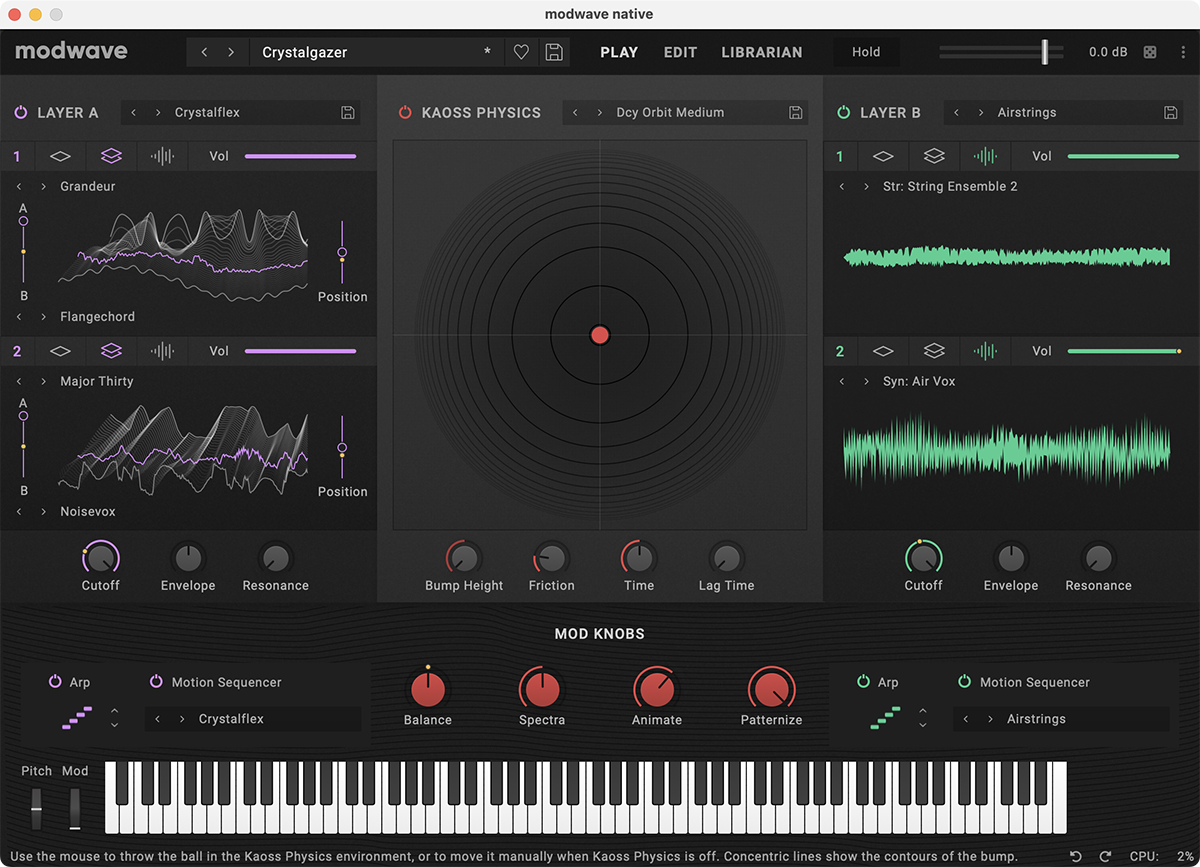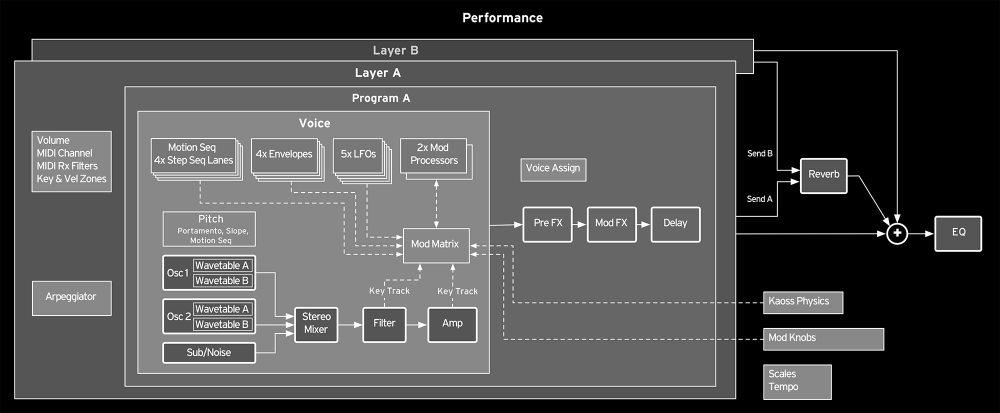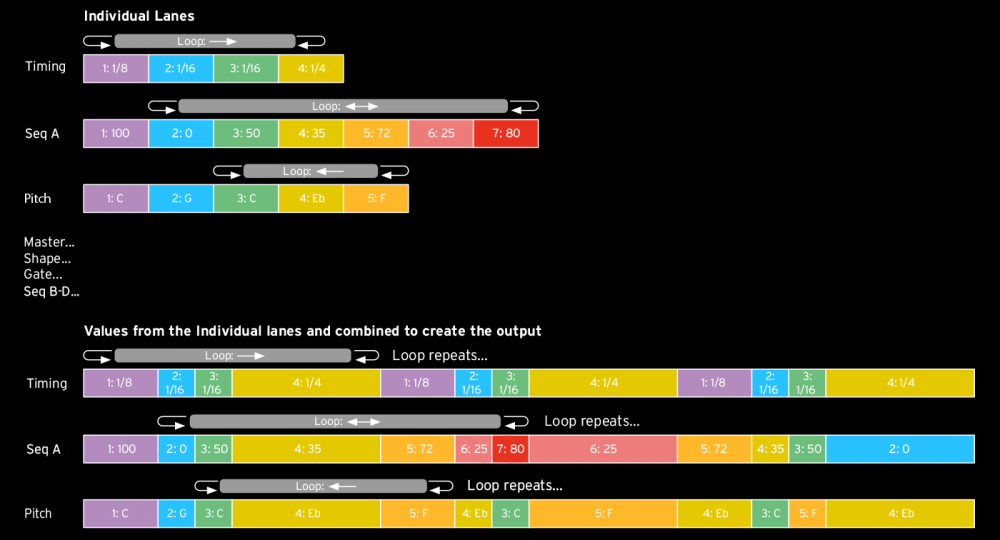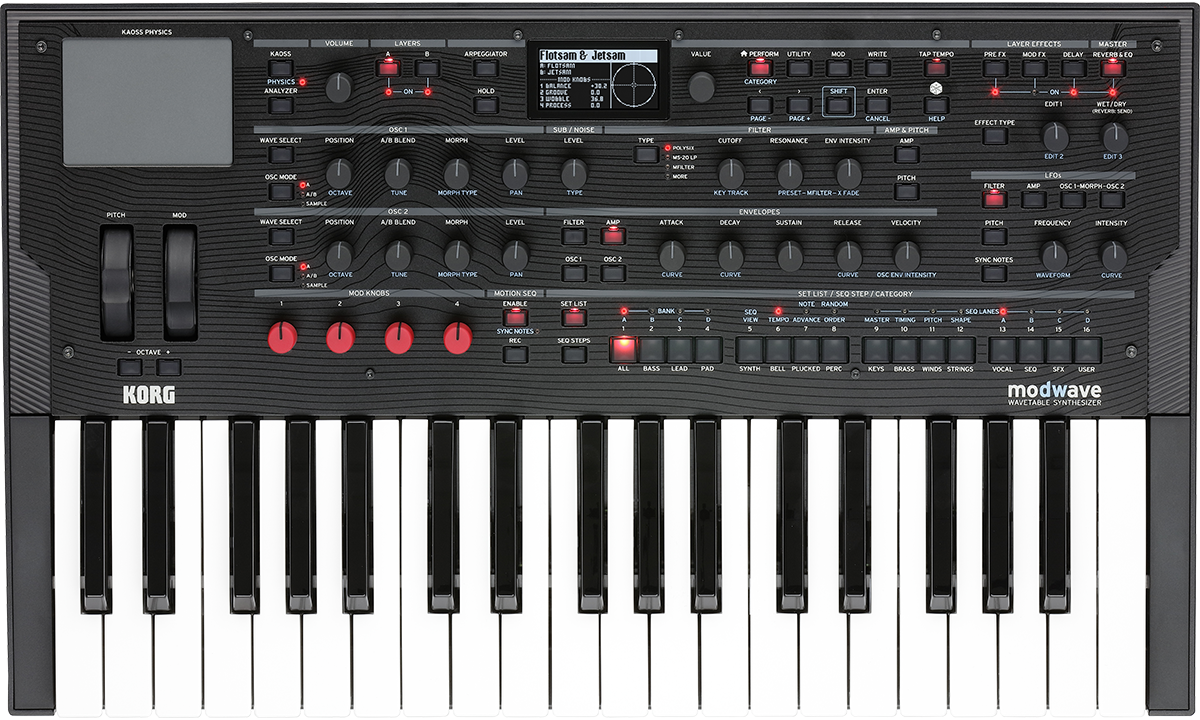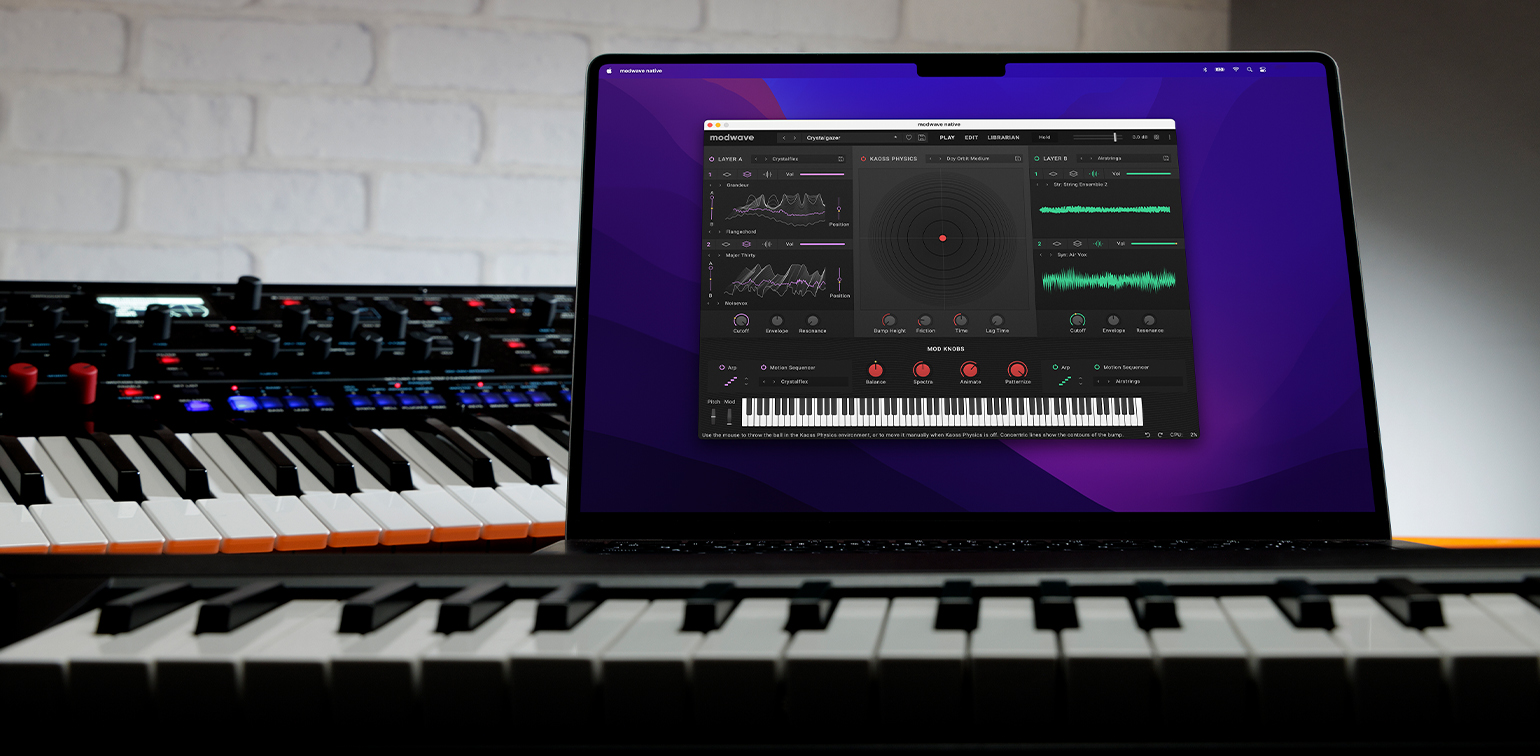
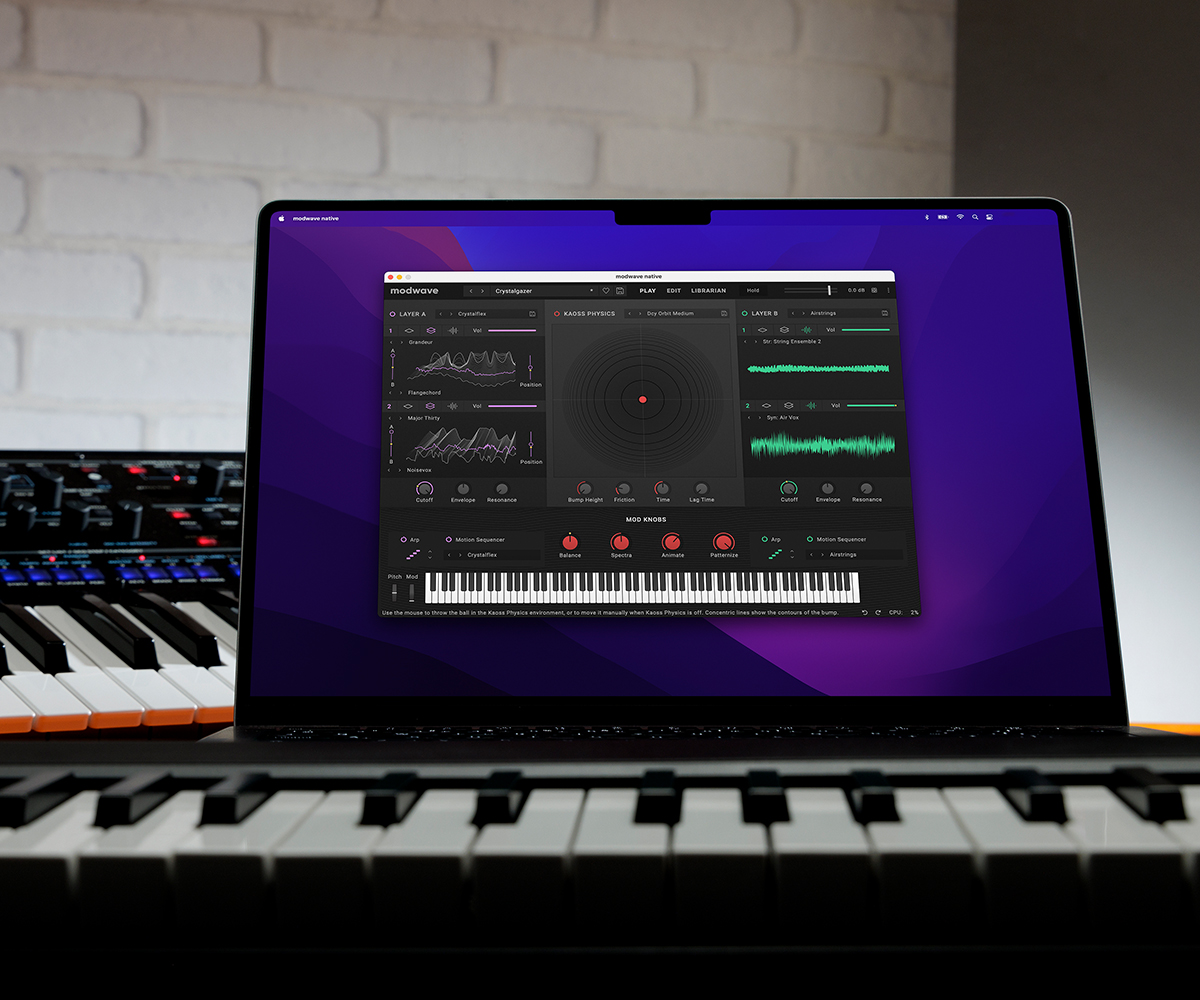
SoundCloud
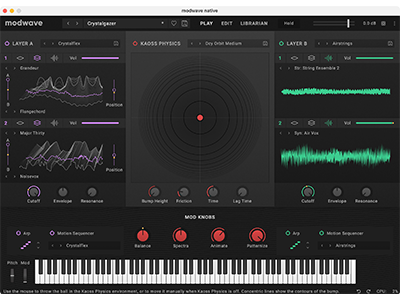
modwave native
WAVETABLE SYNTHESIZER
Support
En savoir plus
Sites connexes
Produits correspondants
Informations correspondantes
Synthesis powerhouse with distinctive wavetable timbres, Kaoss Physics, and Motion Sequencing 2.0. Now available as a plug-in for Mac and Windows.
In 1985, Korg’s DW-8000 combined digital wavetables with rich analog filters to give users sounds which were impossible to create with analog oscillators. It’s still a cult favorite today.
The modwave, released in 2021, builds on the DW legacy and transforms it into a modern monster synth, featuring incredibly deep wavetable oscillators, gorgeous filters, wildly flexible modulation, sophisticated pattern sequencing, and macro controls to deliver unique, powerful, and easily customizable sounds and phrases.
Now, Korg is pleased to announce modwave native, the fully-compatible software counterpart to the hardware modwave synthesizer. modwave native is available in VST3, AAX, and standalone formats on both macOS and Windows, as well as AU on macOS. You can seamlessly exchange sounds between hardware and software. Produce in your DAW with modwave native, and then play the same sounds on stage using the modwave hardware. Create sounds with the hardware’s hands-on interface, and then share them with a computer-based collaborator. Plus, you can use any of the many third-party sound libraries available for the hardware modwave, as well as sample libraries designed for either the modwave or wavestate.
- Special crossgrade from hardware modwave
- modwave synthesis engine
- Kaoss Physics
- Motion Sequencing 2.0
- Deeper into the synth engine
- Filters for days
- Astonishingly flexible modulation
- An arsenal of effects
- Randomization that inspires
- Set Lists and Smooth Sound Transitions
- Designed by KORG R&D in California
- Patch exchange between modwave and modwave native
- First, try the demo version
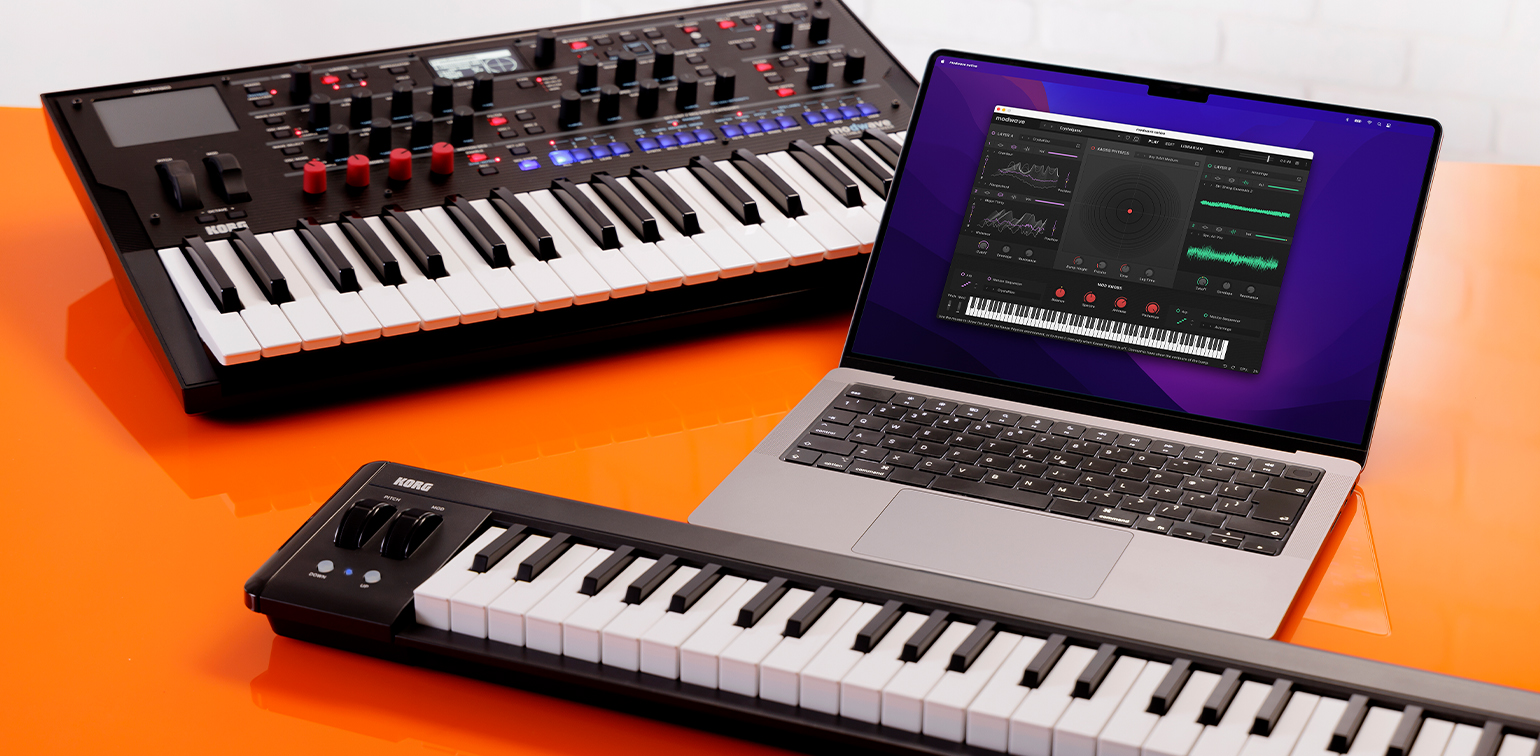
Special crossgrade from hardware modwave
Owners of the hardware modwave are eligible for a crossgrade license to modwave native at the special price of US $49.99, via a coupon code tied to the modwave hardware’s unique ID. Using the hardware and software versions together, you can have the best of both worlds: a physical instrument that responds to your touch, and complete DAW integration. To generate the coupon:
1. Download modwave system version 1.1.3 or later and modwave Editor/Librarian 1.1 or later.
2. Update your modwave hardware, and install the new Editor/Librarian.
3. In the Editor/Librarian, open the File menu and select "Get Plug-in Coupon…"
4. A dialog will appear with the coupon code; follow the on-screen instructions to use the coupon in the KORG Shop.
modwave synthesis engine
When we call the wavetable oscillators "deep," we are not kidding. Start with over 200 wavetables, each containing up to 64 waveforms—from thousands of individual waves. Use the 30+ Modifiers to change their basic character, and the 13 Morph Types to process them in real-time. Create new hybrids from any two wavetables using the unique, realtime A/B Blend. Quick math: that's over 230 million wavetable variations out of the box, and that’s before you even add modulation.
No need to stop there, though! Expand your palette even more by importing new wavetables. Try the many free and commercial wavetable libraries in the standard Serum format*, or create your own using the free, cross-platform WaveEdit, available in a custom version for the modwave. Layer wavetables with samples from the built-in, multi-gigabyte PCM library, import your own samples using Korg’s Sample Builder software, or load samples from the growing number of third-party libraries for wavestate and modwave.
* If an imported wavetable has more than 64 waveforms, it is assumed to be a generated crossfade, and some of the intermediate waveforms are dropped to create a 64-waveform version.
Each Program has two full-featured wavetable oscillators, plus a sub oscillator/noise generator and any of a dozen stereo filter types, including the aggressive MS-20, sweet Polysix, and the newly enhanced Multi Filter. Animate almost any parameter using the massively flexible modulation system, with four triggerable envelopes, five LFOs, dual mod processors and two key-track generators–plus multi-lane Motion Sequencing and Kaoss Physics. Layer two Programs together for double the possibilities.
Kaoss Physics
Kaoss Physics models a ball rolling on a surface and/or bouncing off walls. "Throw" the ball with a gesture on your mouse or trackpad, or launch the ball automatically using a trigger source such as Gate + Damper. You can also directly control the ball by dragging without releasing. Use DAW automation to record both gestures and direct control. The position of the ball produces four modulation signals, which can be used to control any modulation destination you like: the X and Y locations, the distance from the center, and the angle relative to the X axis. The result is an interactive controller that amplifies your physical gestures, transforming them into captivating, complex, and evolving musical results.
There is a bump in the virtual surface, going either down or up, like a valley or a hill. You can set the height or depth of the bump, and choose one of several different shapes for its slopes. The surface has adjustable friction, so that the ball slows down as it travels. There are walls on the four sides of the surface, and when the ball hits a wall, it bounces off. Walls can slow down the ball, as if they were padded, or accelerate the ball, like bumpers in a pinball machine. The walls can also be removed entirely, so that the surface wraps around to the opposite edges like a vintage arcade game.
The modeled environment can create specific modulation effects. For instance, use a centered bump with negative height so that the modulation values always eventually return to 0. Or, position a bump with positive height on a side or a corner, to push modulation values away from that zone
Most parameters, including Tilt, Friction, Time, Bump Height and Position, etc. are modulatable. You can even modulate them from the Kaoss Physics outputs—for instance, try modulating Tilt X with Kaoss Y.
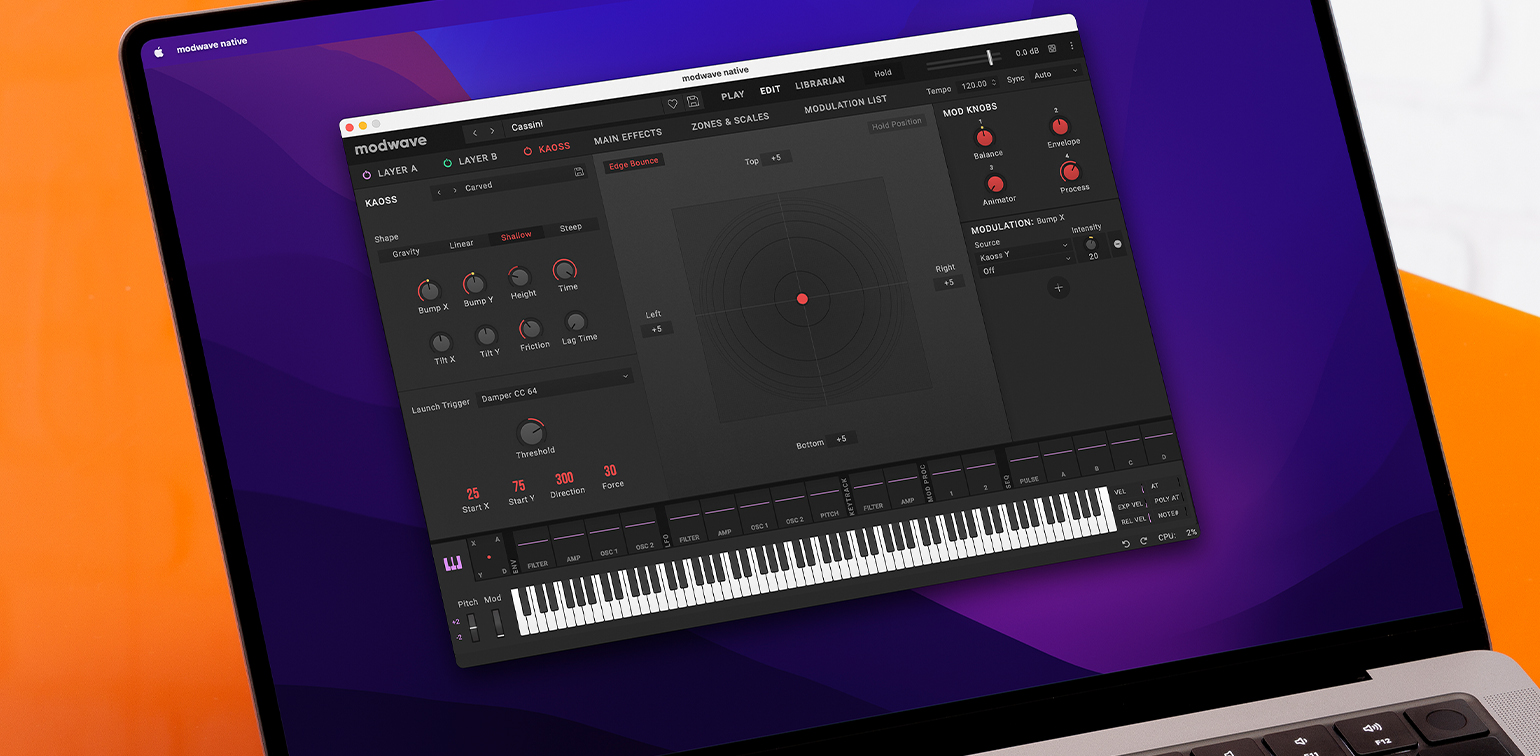
Motion Sequencing 2.0
Motion Sequencing 2.0 is evolved from the wavestate’s Wave Sequencing 2.0. Timing, Pitch, Shape, and four sets of Step Sequence values are separated into “Lanes,” each with their own loop start and loop end, adding a deeper, more customizable level of phrase and modulation recording.
Every time the sequence moves forward, the individual Lanes are combined to create the output. For instance, a step sequence value may be matched with a different duration, pitch, and shape every time that it plays. You can modulate each Lane’s loop points separately for every note, using velocity, LFOs, envelopes, Mod Knobs, or other controllers. Each note in a chord can be playing something different!
Lanes can also randomize the step order every time they play. Finally, individual steps can be randomly skipped, with a modulatable probability from 0 to 100%. The result is organic, ever-changing sounds that respond to your control. The dual arpeggiators can interact with Motion Sequences for even more possibilities.
Deeper into the synth engine
What's a wavetable?
Wavetables are sets of single-cycle digital waveforms, arranged in a specific order. The wavetable's "position" determines which waveform is played. Moving the position with an envelope, LFO, or other modulation source creates subtle or dramatic changes in timbre. Some wavetable systems switch abruptly from one waveform to another; others crossfade smoothly between them. The modwave can do either one.
Modifiers
Use over 30 Modifiers to alter the character of any wavetable at load time. For instance, isolate the odd or even harmonics, add weight through anti-aliased quantization or saturation, or revisit the gritty character of old-school wavetable synths with the Vintage 8 & 12 options.
Morph
The 13 Morph Types let you stretch, squeeze, reflect, and otherwise alter the wavetables in real-time, changing their timbre and—when modulated—creating additional motion in the sound. Sync creates classic swept-sync timbres, using only a single oscillator. Three special Morph Types—FM, AM, and Ring Mod—modulate Osc 2 with Osc 1, and the last two even apply to samples.
A/B Blend
Using the unique A/B mode, oscillators can blend any two wavetables with phase-synchronous precision—different from simply layering voices—opening up a dimension of intermediate waveforms. Add body to otherwise "thin" waveforms, for instance, or a touch of sizzle to a mellow timbre. Even fade between two different "modifier" versions of the same wavetable. A/B Blend can be modulated in real-time, of course.
Gigabytes of samples
Wavetables also sound great when layered with samples, and the modwave oscillators handle that with aplomb, using KORG’s proprietary anti-aliasing sample playback technology. Totaling in the gigabytes, the modwave’s sample library includes new material from KORG, Airwave, and Francis Preve, plus a bank from Plugin Guru and a selection from the Kronos and Krome libraries.
User Sample Banks let you add more Multisamples to the system. You can create your own Banks, or use Banks from third party sound developers. modwave native can load many User Sample Banks simultaneously. This is one area in which software has the edge, due to the large amount of storage and RAM available on your computer: the hardware modwave can load only one User Sample Bank at a time.
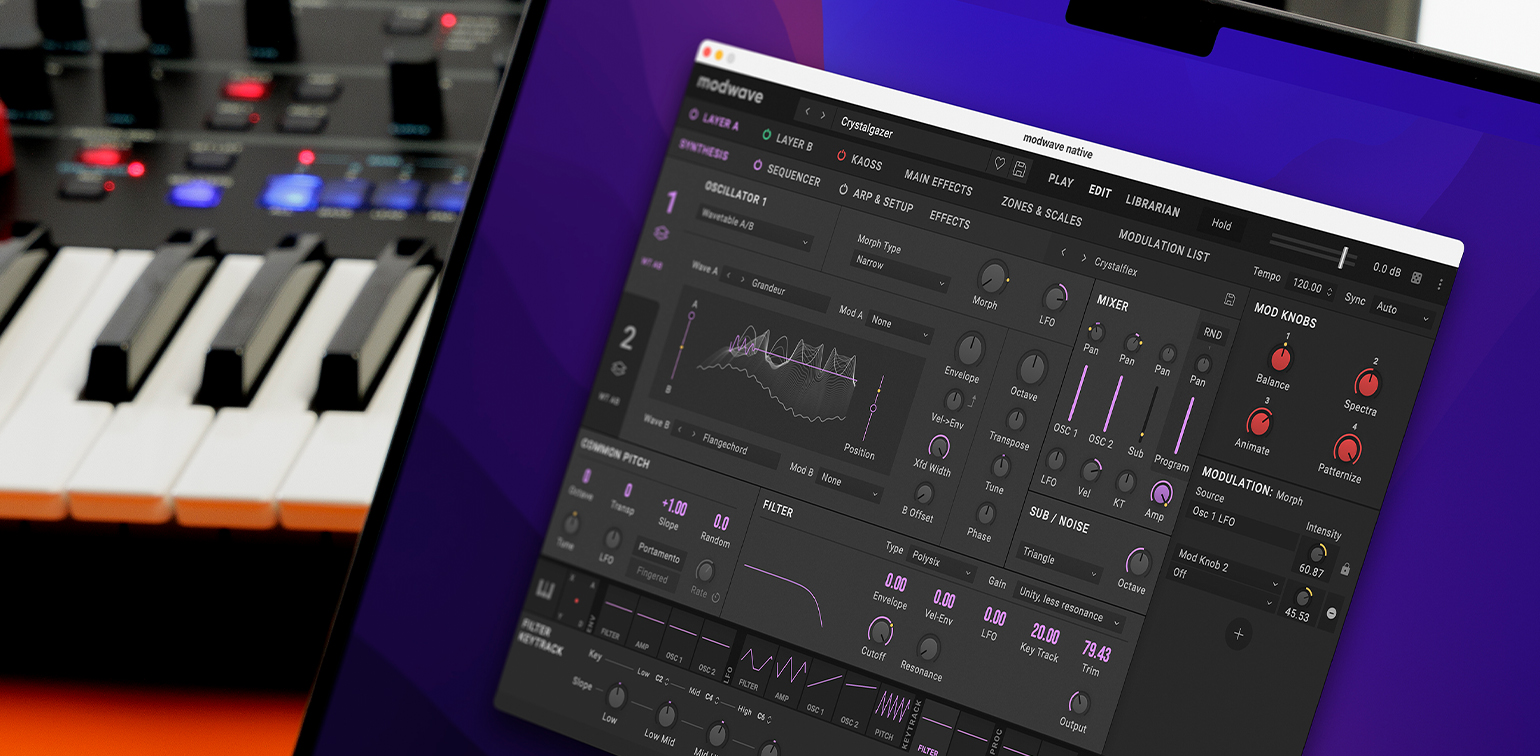
Filters for days
Add vintage character to your sounds with the aggressive MS-20 Lowpass or Highpass filters, or the strong, sweet Polysix Lowpass - all newly enhanced with gain controls to make it easier to dial in the resonance timbre. Shape and refine with a full collection of resonant 2-pole and 4-pole Lowpass, Highpass, Bandpass, and Band Reject filters. Or, step outside the box with KORG’s unique Multi Filter, which creates modulatable blends of multiple modes simultaneously.
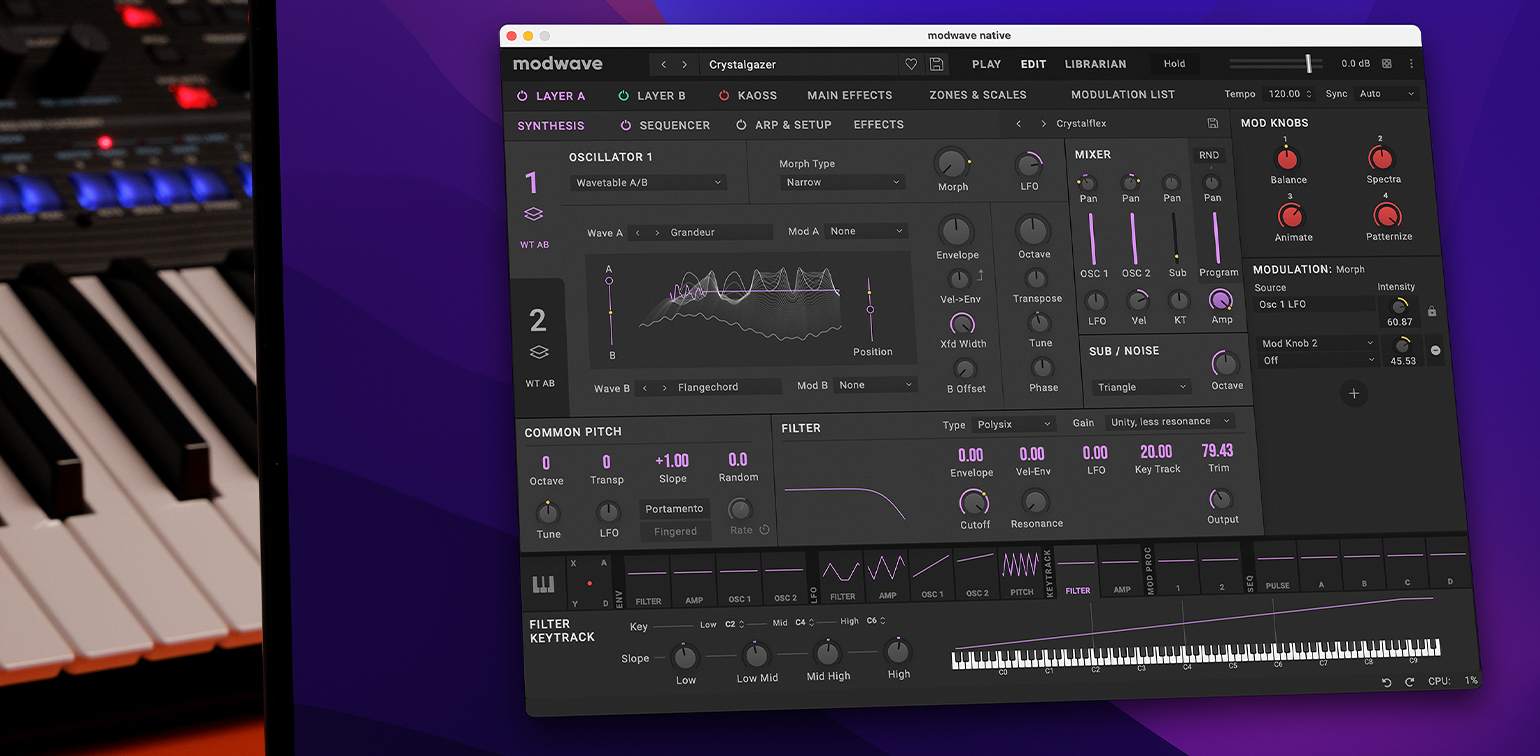
Astonishingly flexible modulation
Bursting with modulation sources and destinations, the modwave invites you to explore. Most parameters can be modulated, with more than a thousand modulation destinations per Performance, and no fixed limit on the total number of modulation routings. You can even modulate settings for individual Motion Sequence Steps! Each modulation routing includes a primary modulation source, an intensity, and a secondary modulation source; the three are multiplied together to create the modulation amount. A single destination, such as Filter Cutoff, can have up to 31 incoming modulation routings.
Mod Knobs put macro transformations under your fingertips, making it easy to explore the sonic worlds inside each Performance. Tweaking an existing sound? Quickly identify modulation sources using real-time displays of all envelopes, LFOs, and other primary modulation sources. Easily create modulation routings using drag-and-drop, and get an overview of all routings via the Mod List. Mod Processors let you transform modulation signals using quantization, smoothing, curvature, and more.
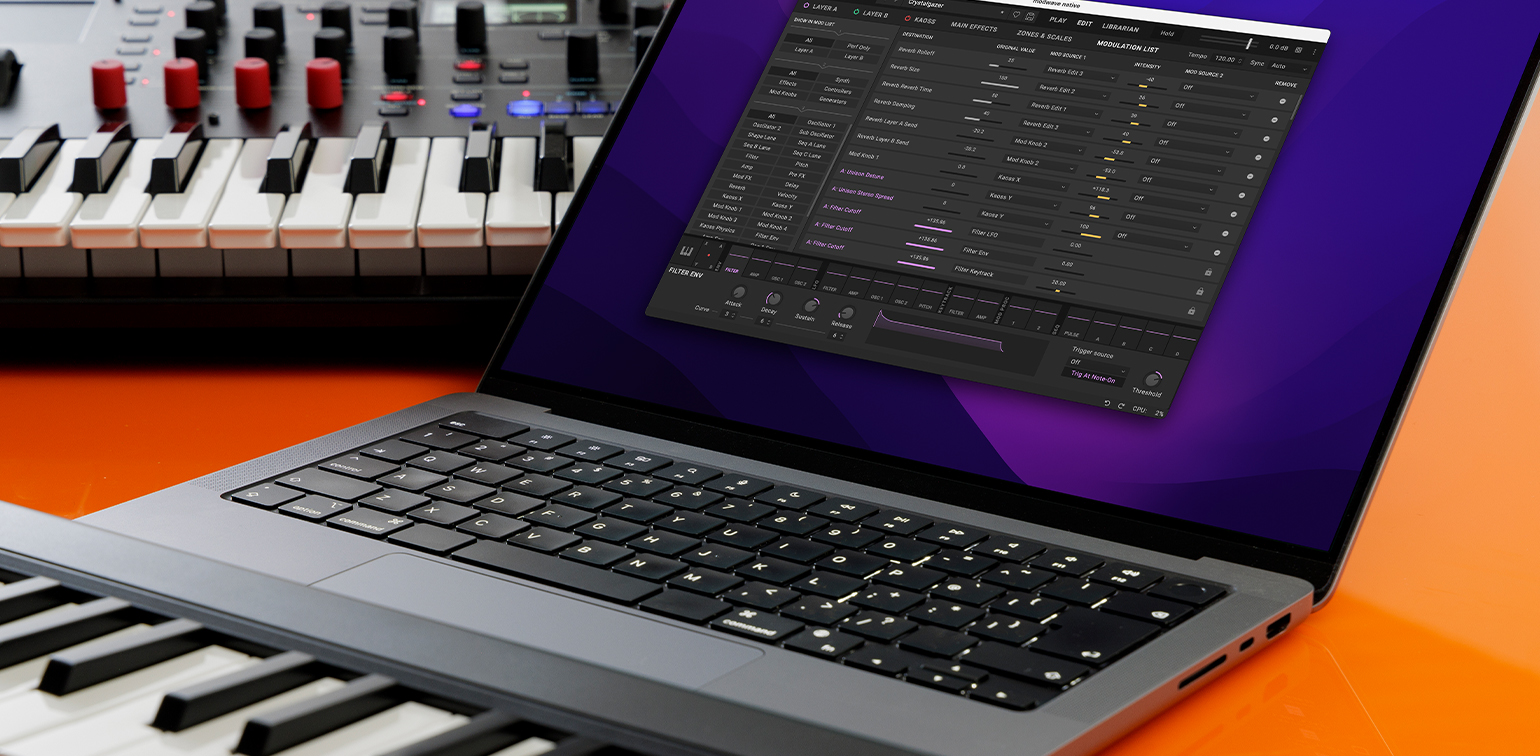
An arsenal of effects
The modwave’s superb effects deliver production-ready sounds. Each Layer has three dedicated effects, plus a send to the Performance's master reverb, followed by a master parametric EQ. Along with standards such as compressors, EQs, choruses, flangers, phasers, and stereo delays, you’ll find distinctive processors such as the Wave Shaper, Talking Modulator, Reverse Delay, Multiband Mod Delay, and Overb (from the OASYS and Kronos), plus modeled effects including VOX guitar amps, VOX wah, multi-head tape echo, and a collection of classic guitar pedals.
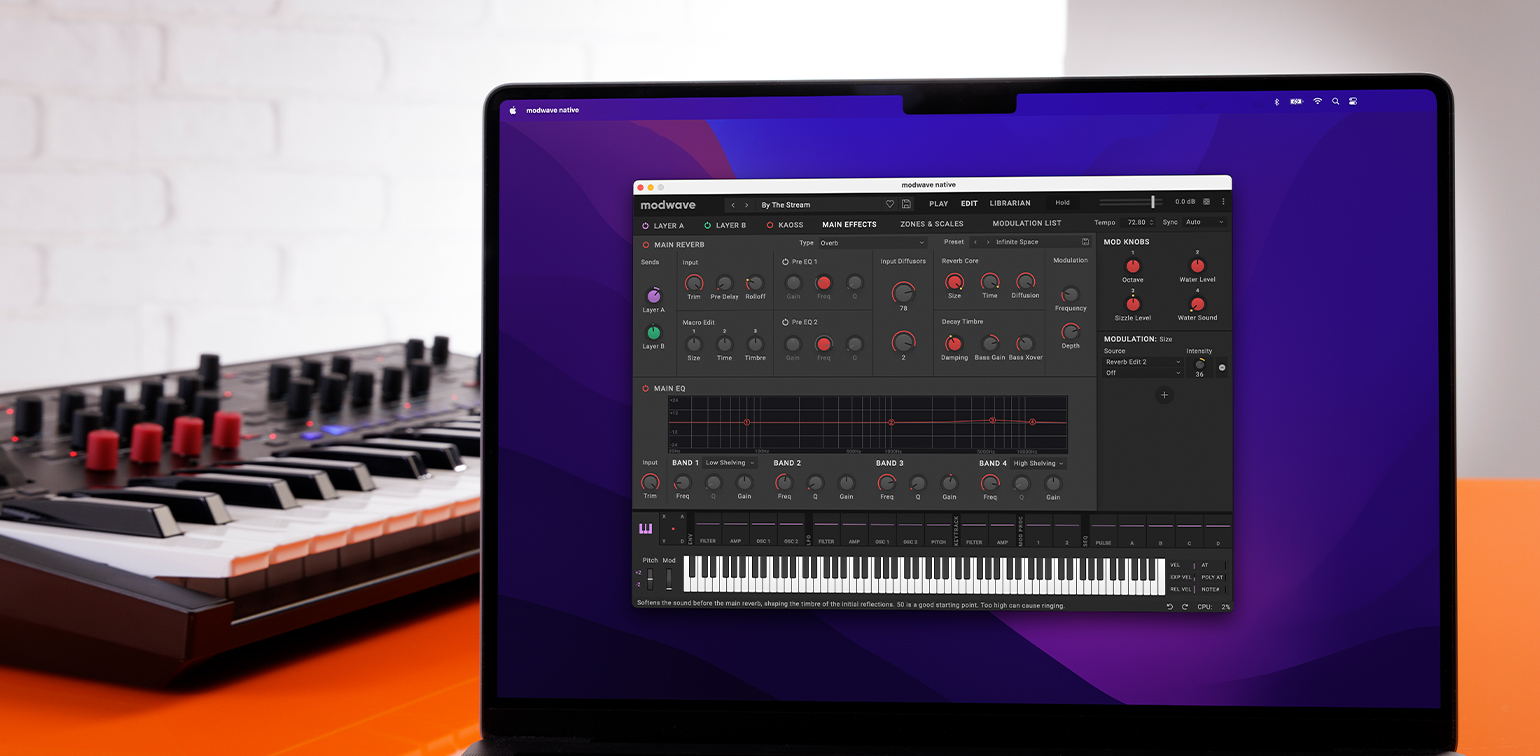
Randomization that inspires
Looking for even more inspiration? The “dice” icon at the top of the window generates new sounds via intelligent randomization. Randomize the entire sound or just a part of it, such as the oscillators, filter, or effects. Use the results directly, or as a jumping-off point for your own creations.
Set Lists and Smooth Sound Transitions
Set Lists offer effortless organization of your modwave Performances, and deliver instant access at the gig or in rehearsal. Smooth Sound Transitions allow previously-played voices and effects to continue to ring out naturally, even once a new sound has been selected.
Designed by KORG R&D in California
KORG R&D created the wavestate and the original Wavestation, co-created the OASYS and Kronos, and has developed fundamental technologies behind many other KORG instruments. The modwave reflects their unique aesthetic, delivering stunning sound, deep flexibility, and immediate physical control via cutting-edge technologies. Key sound designers from the wavestate, Airwave and Peter “Ski” Schwartz, joined Francis Preve, Richard Devine, and the Korg voicing team to create the modwave’s incredible sound library.
Patch exchange between modwave and modwave native
Sounds created with modwave or modwave native can be used interchangeably, transcending hardware and software boundaries.
To import and export sounds, use the Librarian page in modewave native, and the modwave Sound Editor/Librarian for the modwave hardware. For detailed instructions on how to use the modwave Sound Editor/Librarian, please refer to the user's manual that comes with the modwave Sound Editor/Librarian.
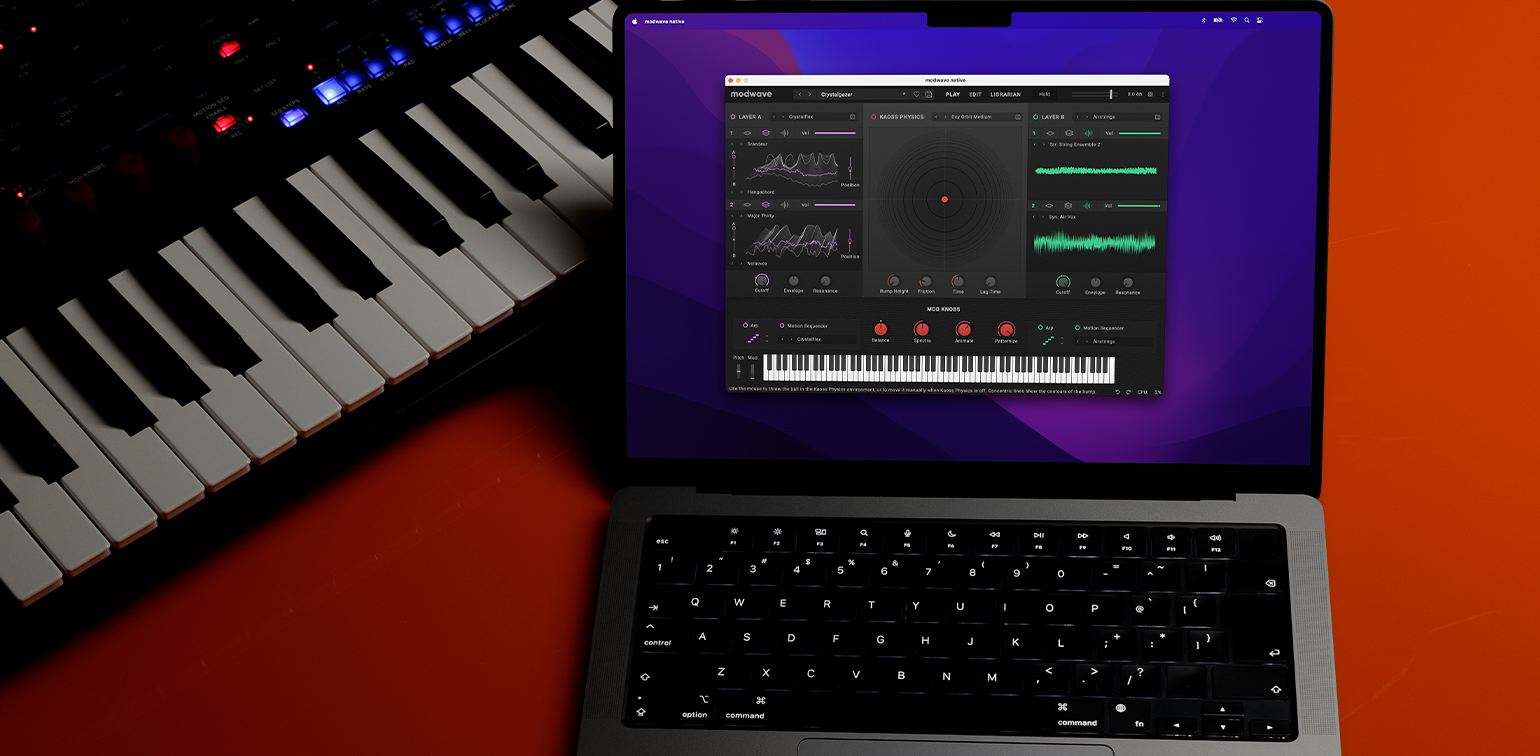
First, try the demo version
Before authorization, modwave native runs in a free demo mode. You can play all of the sounds and explore all of its incredible capabilities, with only two restrictions: the software can only be used for 20 minutes at a time, and saving is disabled. To get started, create a free KORG ID account, download the Korg Software Pass (KSP) installation manager, and then use KSP to to install the demo.
modwave
modwave also introduces two unique new tools for creating dynamic motion: Kaoss Physics and Motion Sequencing 2.0. Kaoss Physics combines an x/y Kaoss pad with modulatable game physics to create a responsive, interactive controller that is—besides being powerful— a lot of fun to explore. Motion Sequencing 2.0 brings the organic, continuously evolving patterns of the wavestate's Wave Sequencing 2.0 into the world of motion sequencing, including multiple lanes and real-time recording to help you create complex and evolving phrases that other step sequencers cannot.
Like Wave Sequencing 2.0 (wavestate) and altered FM (opsix), modwave’s evolved wavetable synthesis delivers its own brand of completely unique sounds and a knob-per-function layout that makes customizing those sounds fast and easy. There are hundreds of preset sounds empowered by this new architecture, organized by front-panel category buttons, and all instantly customizable via the four Mod Knobs. modwave's distinctive wavetable timbres start with aggressive basses & leads, and lush ambient pads which will add a new dimension to your tracks. But that is just the beginning.






